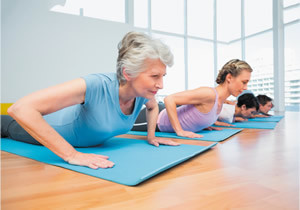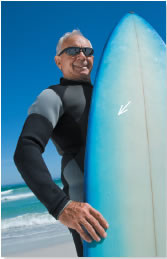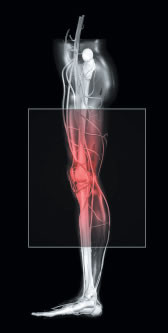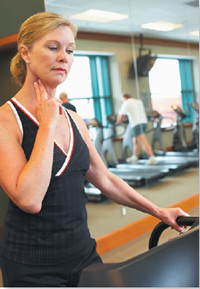
Zinc: What it does for the body, and the best food sources

Respiratory health harms often follow flooding: Taking these steps can help

Tips to leverage neuroplasticity to maintain cognitive fitness as you age

Can white noise really help you sleep better?

Celiac disease: Exploring four myths

What is prostatitis and how is it treated?

What is Cushing syndrome?

Exercises to relieve joint pain

Think your child has ADHD? What your pediatrician can do

Foam roller: Could you benefit from this massage tool?
Exercise & Fitness Archive
Articles
Osteoarthritis relief without more pills
It's possible to ease arthritis pain and stiffness without medication, but it takes some work. |
Here are some steps you can take to reduce your reliance on medication to control symptoms and stay functional.
Moderate- and high-intensity workout both burn belly fat
What's better for you: moderate but prolonged exercise, or a shorter but more intense workout? A recent study in Annals of Internal Medicine found that both levels of exercise will help you lose about the same amount of belly fat if you burn the same number of calories. But only high-intensity exercise helped control blood sugar levels.
In the study, 300 people with abdominal obesity walked and jogged on treadmills at a moderate or high intensity, burning equivalent numbers of calories. The 217 people who stuck through the study for the entire six months lost on average 1.75 inches from their waistlines—about 5% to 6% of body weight. It made no difference whether they huffed through the higher-intensity workout or the more moderate regimen.
Core workout can cause muscle soreness
Many popular workouts that aim to strengthen your arms, legs, and abs give short shrift to many of the muscles that form your body's core (the group of muscles that form the sturdy central link connecting your upper and lower body). Strong core muscles are essential to improving performance in almost any sport — and are the secret to sidestepping debilitating back pain.
If you haven't been working your core muscles regularly — or if you challenge yourself with a new set of exercises — expect to feel a little soreness as you get used to your new routine.
Yoga's health advantages may extend to the heart
New research suggests yoga may be as good as moderate exercise for lowering heart disease risk. Images: Thinkstock |
With its focus on body, mind, and breath, yoga shows promise for improving heart health.
Feeling young at heart may help you live longer
People who feel young at heart are more likely to pursue physical activity, even it's an activity that's challenging. |
A youthful attitude may lead to better eating and exercising habits.
Could that leg pain be peripheral artery disease?
The pain of peripheral artery disease may be felt above or below the knee during activity, and will fade with rest. Image: Thinkstock |
The telltale sign is leg pain and fatigue that comes on with activity and goes away with rest.
Want to get healthier? Get your partner involved!
Plenty of research shows that we tend to exhibit the health behaviors of people around us, and that partners can influence each other's behavior. The influence carries even more weight if an unhealthy partner is making a change for the better. A study published in JAMA Internal Medicine Jan. 19, 2015, found that men and women were much more likely to make positive changes if their partners also changed their health behavior during the same period. The influence on a partner was significant: 67% of men took up physical activity if their wives did, but only 26% became active if their wives did not. The take-home message: get your partner on board if you both need to make healthy lifestyle changes.
Image: Thinkstock
Sitting may increase risk of early death
Even an hour's exercise a day won't protect you from an earlier death, if you spend most of the rest of your day sitting. That's the verdict of Canadian researchers who pored over data from 47 studies on the effects of sedentary behavior. When they combined the results of all the studies, the researchers found that regardless of their levels of physical activity otherwise, people who sat for long periods had an increased risk of developing a host of diseases. People who sat the longest had a 24% greater risk of dying, an 18% greater risk of heart disease, a 13% greater risk of cancer, and a 90% greater risk of diabetes. The results were published in the Jan. 20, 2015, issue of Annals of Internal Medicine.
| The researchers recommend standing for a minute or two every half‑hour when you have a task that keeps you chair‑bound. It may help to set a timer or alarm to sound at half-hour intervals. |
Neck pain: Core exercises can help
Neck aches are often the result of wear and tear, poor posture, and weak core muscles. Image: Thinkstock |
Better support for your spine is key in avoiding neck ache.
Safe exercise: Know the warning signs of pushing too hard
Your heart should beat Image: Thinkstock |
Chest pain, dizziness, and shortness of breath mean you should back off and call your doctor.

Zinc: What it does for the body, and the best food sources

Respiratory health harms often follow flooding: Taking these steps can help

Tips to leverage neuroplasticity to maintain cognitive fitness as you age

Can white noise really help you sleep better?

Celiac disease: Exploring four myths

What is prostatitis and how is it treated?

What is Cushing syndrome?

Exercises to relieve joint pain

Think your child has ADHD? What your pediatrician can do

Foam roller: Could you benefit from this massage tool?
Free Healthbeat Signup
Get the latest in health news delivered to your inbox!
Sign Up










